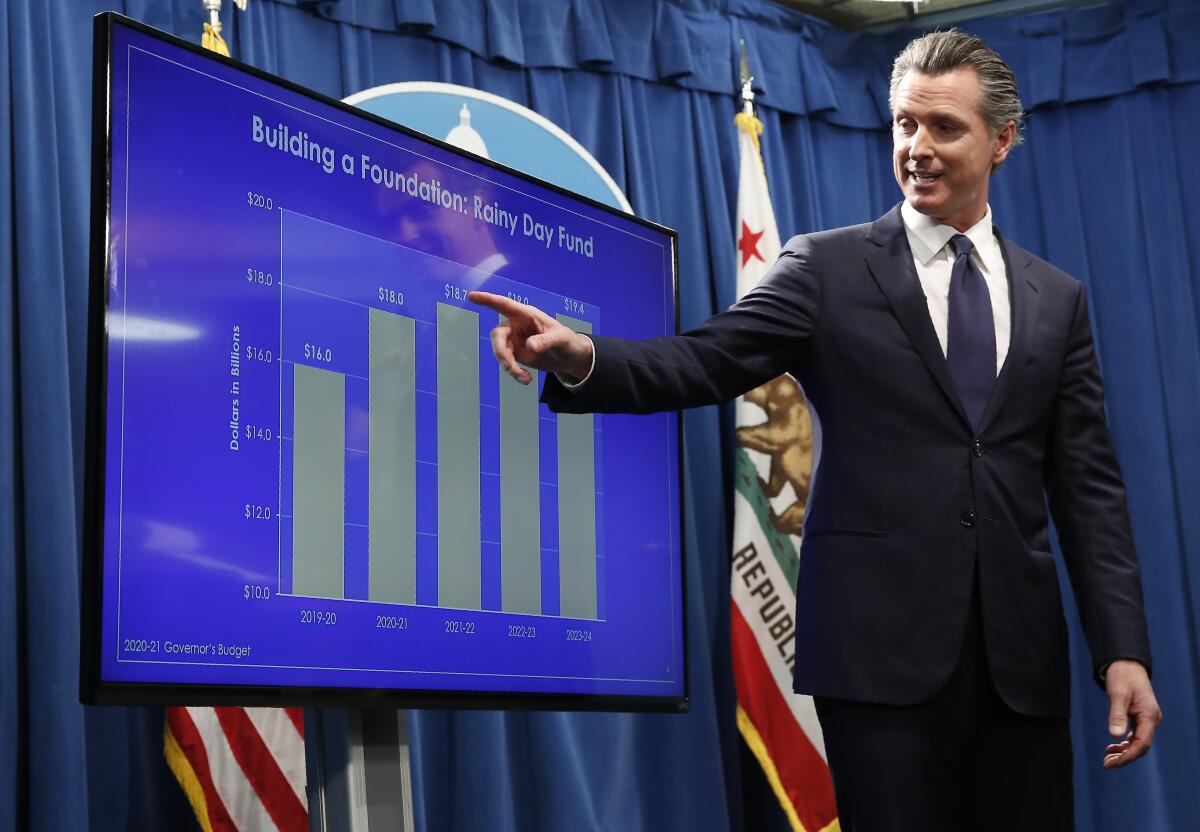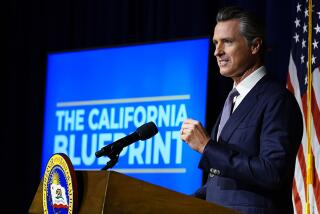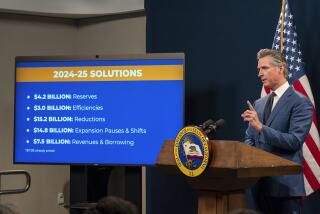Coronavirus threatens to wipe out California’s $21-billion surplus. And it could get worse

- Share via
SACRAMENTO — For more than six years, through two governors and hundreds of lawmakers’ votes, California’s state government slowly built the largest cash reserve in its history — projected to total $21 billion by next summer.
But there are growing fears that the fast-moving crisis sparked by the coronavirus pandemic could force it to be spent in a matter of months.
A number of the state’s most experienced budget watchers now expect that California might need to use the entire cash surplus, and possibly much more money, to prop up vital government services that could be severely underfunded by a quickly collapsing economy.
“This is a sudden downturn unlike anything we’ve seen,” said Gabriel Petek, the state’s legislative analyst. “We’re kind of flying blind at this point.”
Few states bear more scars from crushing budget deficits of the past than California. Three significant economic downturns over the past quarter-century triggered sharp drops in tax revenue, two of which occurred in a single decade. The resulting events were historic: state government paymasters issued IOUs, vital services and school functions were slashed and angry voters removed Gov. Gray Davis from office in a 2003 special election.
But each prior collapse in government funding was a relatively slow-moving disaster. Even the global recession that began in 2008, generally seen as the most quickly unfolding crisis, gave lawmakers time to take corrective measures.
The latest updates from our reporters in California and around the world
Early indications are they will have to act much more quickly to address the COVID-19 emergency — assuming that health concerns eventually lessen and allow legislators to return to Sacramento. And as financial markets shrink and jobless claims grow, the state’s budget situation could deteriorate much faster.
“I don’t think people in California or the country have fully come to grips with the situation that we’re in,” said Assemblyman Phil Ting (D-San Francisco), chairman of the lower house’s budget committee.
On Tuesday, advisors to Gov. Gavin Newsom took the first steps toward creating a triage plan. State agencies were told to assume no funding will exist for proposals they already had in the works, let alone new ideas. And legislators were told the administration will be unable to submit its expected April 1 updates on government revenue and expenses.
“Despite the sustained efforts, the virus continues to spread and is impacting nearly all sectors of California’s economy,” Keely Martin Bosler, the governor’s finance director, wrote to legislative leaders. “Among these impacts is a potentially severe drop in economic activity, with corresponding negative effects on anticipated revenues for the upcoming 2020-21 fiscal year and beyond.”
For much of the 1990s and 2000s, analysts often compared California’s budget to a roller coaster ride of sky-high revenue collections followed by harrowing shortfalls and then back again. Many of those dollars came from the investment profits earned by the state’s wealthiest taxpayers. The volatile nature of tax collections meant little certainty for healthcare, education and social services.
But aside from a meager “rainy day” fund established in 2004, there were few mandates to prioritize savings. That changed in 2014, when voters approved a constitutional amendment that substantially increased the size of the reserve fund and created new rules on how the excess cash could be used.
That fund should total $16 billion by this summer. In addition, as much as $3 billion is expected in a less restrictive reserve account that can be used much more quickly and almost $1 billion more in a special fund to support social “safety net” programs. In all, the surplus cash would equal about one-tenth of the total budget proposed by Newsom in January.
Now, a little more than 10 weeks later, there are threats to all three of the state’s biggest sources of tax revenue: personal income taxes, corporate taxes and sales taxes. Sales taxes, in particular, could be hard hit by the sustained shutdown of the state’s service sector — likely leaving hundreds of thousands of Californians seeking unemployment assistance.
“We haven’t seen anything like this,” said Chris Hoene, executive director of the California Budget and Policy Center. “It’s likely we are going to need every penny of the reserves.”
One major challenge for lawmakers will be working with a lack of solid information. The state Franchise Tax Board has given Californians until July 15 to file their tax returns and pay anything that’s owed. That three-month delay will wipe out a major data point used every year by the governor and the Legislature in writing a new state budget by the constitutional deadline of July 1.
Instead, budget analysts expect that a series of fiscal actions will be needed throughout the spring and summer. Lawmakers could be asked to extend their work beyond the traditional end of legislative action in August, taking budget actions related to the coronavirus response into the fall — even as many of them are up for reelection in November.
Few budget needs will be more closely watched than healthcare. Local governments are likely to ask state officials for substantial increases in public health funding, beyond the $1 billion in spending approved by the Legislature last week.
Huge new costs, too, are probable for Medi-Cal, the state’s free healthcare for its poorest residents. There are already some 13 million Californians enrolled in the program. The economic challenges ahead could add as many as 1 million people to the program, said Anthony Wright, executive director of Health Access, a healthcare advocacy group.
“Because this is a public health emergency, I think it would be ill-advised to have the same proposals we had a decade ago to cut people off from coverage,” Wright said.
One notable change from the past recessions is the existence of the federal Affordable Care Act, which eliminated some of the more stringent eligibility rules for Medi-Cal and also created health insurance exchanges such as Covered California,which offer subsidies to low- and middle-income citizens.
“That’s a safety next that didn’t exist before,” Wright said.
But those costs, while likely to be underwritten by the federal government, will also require more state tax revenue spending. In past budget deficit debates in Sacramento, lawmakers grappled with determining which of the many vital needs would have to go unmet. Economic slowdowns mean less money for health and human services programs — the same services that see higher demand when millions find themselves with less work or no work at all.
“Every one of these programs is going to have a legitimate need, and they’re all going to have the word ‘billion’ by them,” said Hoene, whose organization advocates for programs aimed at helping low-income Californians.
No part of the state budget is bigger or more subject to strict rules about spending than K-12 schools. It has taken most of the last decade for debts incurred to schools during the last recession to be repaid. A number of school districts are still struggling with a variety of costs, including sizable pension obligations to teachers and other employees.
“This could have just devastating impacts on education,” said Kevin Gordon, a longtime schools lobbyist in Sacramento.
While public schools and community colleges are guaranteed a share of state tax dollars, the formulas that govern that spending also mean the minimum level of funding will go down as revenues disappear. Gordon said that, under current law, it is likely that schools could withstand a total statewide revenue loss of around $5 billion. But more than that and schools will face significant problems, he said.
“We’re hoping that the administration and the Legislature try to protect schools from the hit that the minimum [funding] guarantee would otherwise allow them to do,” Gordon said.
Schools closed in response to coronavirus fears are already feeling serious fiscal pressures. The Los Angeles Unified School District said it’s spending $100 million in cash reserves to provide the technology needed for remote learning by students from low-income families. And the district’s leaders, along with school officials in San Diego, have said their long-term budgets are no longer in balance.
A collapse in state tax revenue projections would trickle down to local governments too. The sweeping realignment of many public safety programs to county government control in 2011 has been paid for by steady growth in state dollars. Some counties could have to offer the same or more services with less in the event of a state budget shortfall.
The rules for using the state’s rainy-day fund state that only half of the money, perhaps around $8 billion, could be used in any single fiscal year. But lawmakers could easily use the first half to prop up program costs in the current fiscal year that ends June 30, which ends on June 30 —and then quickly enact a plan for the rest of the money in the budget year that begins on July 1.
Legislative leaders realize they will have unprecedented challenges ahead, but appear to be heartened by the fact that the $21-billion cash surplus even exists. While much of it would have been set aside by legal mandate, lawmakers have occasionally added extra payments into the rainy-day fund.
“The good news is, thanks to 10 years of responsible budgeting, we have never been more prepared than we are today to face tough budget times,” Senate President Pro Tem Toni Atkins (D-San Diego) said.
Times staff writer Howard Blume contributed to this report.
More to Read
Sign up for Essential California
The most important California stories and recommendations in your inbox every morning.
You may occasionally receive promotional content from the Los Angeles Times.











